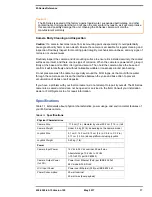
Installing M-Series Camera Systems
432-0003-60-12 Version 100
May 2017
8
Camera Mounting Options
The M-Series camera can be installed in an upright or upside down position.
Caution!
In most installations, the M-Series is mounted upright on a
mounting surface, with the pan/tilt base below the camera—ball
up orientation. Optionally, the unit can be hung upside down—ball
down orientation. Unless otherwise noted, these mounting
instructions assume an upright installation; refer to
Mounting
Upside Down, pg. 12
for information about ball down installations.
Verify that both sides of the mounting surface are accessible. With
the supplied hardware, the camera can be mounted to a platform
that is up to 41 mm (1.6 in.) thick. Depending on the thickness of
the mounting platform, the installer can choose to provide other
mounting hardware, rather than using the supplied threaded studs
and nylock/acorn nuts. The camera mounting surface must be at least as large as the footprint of
the camera itself to ensure an adequate seal with the O-ring.
You do not need to remove the screws in the base of the camera or disassemble the camera unit.
The camera unit is sealed at the factory. Disassembling the camera will compromise the seals and
will void the warranty.
Top-Down Installation Kit
If it is not possible to access the space on the other side of the
mounting surface, you can mount the camera using the top-down
mounting accessory kit. This type of installation makes use of a
mounting riser, an optional accessory available from FLIR
Systems, Inc.
To install using the mounting riser, the camera is first mounted to
the mounting riser, then the riser is secured to the surface with
screws from above. The mounting riser allows space between the
camera base and the mounting surface for the cable connections.
Camera Video Options
The M-Series camera assembly has either one or two video cables:
• The cable labeled IR is for the composite—also known as analog—video signal from the
thermal (infrared) camera. This is the only cable on single payload cameras.
• On dual payload models, the cable labeled VIS/IR can source the video signal from the thermal
camera or the DLTV camera as controlled from the JCU.
When mounted in a ball-down position, ensure adequate drainage such that standing water
does not collect above the cable glands. Standing water will eventually seep past the cable
gland seals and compromise the electronics. Failure to properly install or seal these glands may
void the camera warranty.
Upside down
Upright
(ball up)
(ball down)
Top-down riser








































